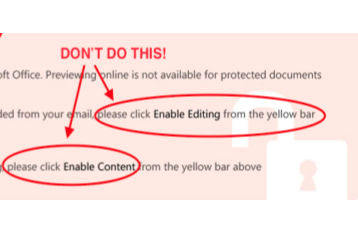
Macros are small bits of programming used in Microsoft Office docs to automate tasks. Unfortunately, they can also spread viruses and malware, and anti-virus programs cannot always catch them. Infected Office docs are typically spread through email attachments or download links, or even through cloud services like Office 365.
What you can do
- If you were not expecting an email attachment or shared doc check with the sender before opening it.
- Look at the URL/address. Hover over links in emails with your mouse to reveal the actual URL or web address. If it is not a familiar address or a service U-M uses for document sharing, don’t click.
- Preview the doc in U-M Google Drive. Google will not run Microsoft macros, making it a reasonably safe way to save and preview Office docs if you are not sure what it is in them.
What not to do
- Do not enable macros or content. Check with the document owner/sender and ask them if macros need to be enabled and why.
- Do not open or download a document from an unfamiliar sender. Look at the “from” and “reply to” lines, and do not open or download if the sender is unknown to you.
- Do not open or download a document shared or stored on a system or service you are unfamiliar with.
See Phishing & Suspicious Email for more about avoiding online dangers.
